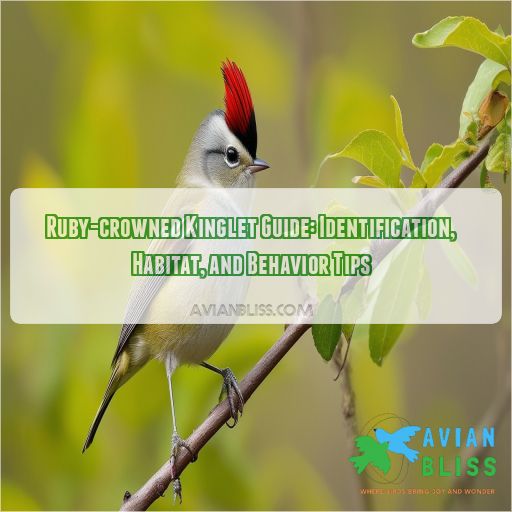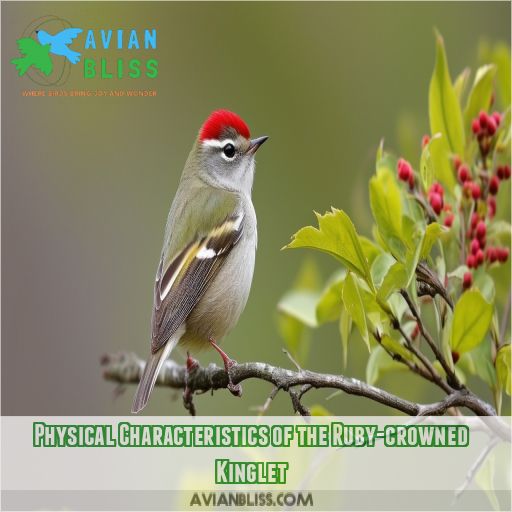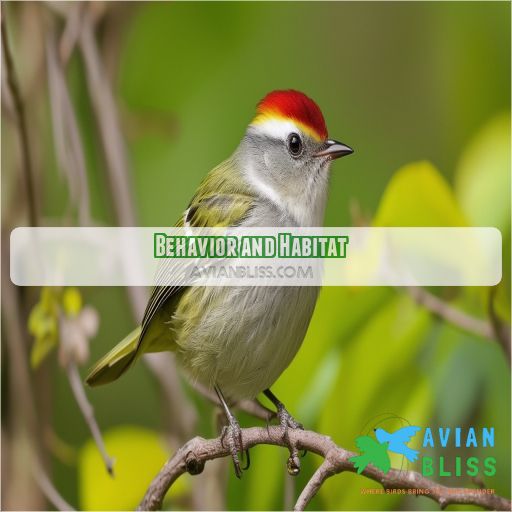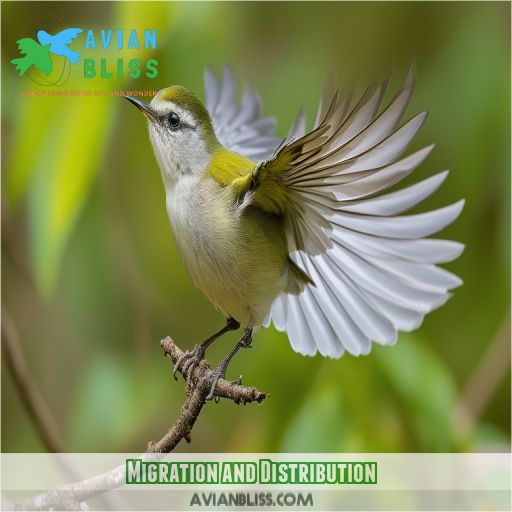This site is supported by our readers. We may earn a commission, at no cost to you, if you purchase through links.

You’ll spot them by their white eye-ring and wing bars, but their size is the real giveaway – they’re among the smallest birds around. Listen for their loud, jumbled song and high-pitched "ji-dit" call.
These restless birds build intricate nests high in conifers, laying up to 12 eggs – a clutch that’s massive relative to their size.
There’s more to uncover about these fascinating feathered friends.
Table Of Contents
- Key Takeaways
- Physical Characteristics of the Ruby-crowned Kinglet
- Behavior and Habitat
- Identification Tips
- Vocalizations
- Nesting and Reproduction
- Migration and Distribution
- Frequently Asked Questions (FAQs)
- Do female ruby-crowned kinglets have a red crown?
- How do you tell the difference between male and female ruby-crowned kinglets?
- What are some interesting facts about the Ruby-crowned Kinglet?
- Are ruby-crowned kinglets migratory?
- What do Ruby-crowned Kinglets eat in winter?
- How long do Ruby-crowned Kinglets typically live?
- Do Ruby-crowned Kinglets form flocks with other species?
- Can Ruby-crowned Kinglets be kept as pets?
- How do Ruby-crowned Kinglets cope with extreme cold?
- Conclusion
Key Takeaways
- Talk about a pocket-sized powerhouse! These olive-green cuties are barely 4 inches long but pack a punch with their loud, jumbled songs and frantic foraging. They’re the avian equivalent of that one friend who’s always bouncing off the walls after too much coffee.
- The guys in this species are real show-offs, sporting a hidden ruby crown that they flash when they’re feeling frisky. It’s like nature’s version of a secret handshake – now you see it, now you don’t!
- These pint-sized parents are overachievers in the nest department. They build intricate nests high up in the trees and lay up to 12 eggs – that’s like a human giving birth to a dozen babies at once! Talk about a full house.
- Don’t blink or you’ll miss ’em! Ruby-crowned kinglets are constantly on the move, flitting through forests faster than you can say "bird watching." They’re the masters of mixed-species flocks, proving that even the tiniest birds can be social butterflies.
Physical Characteristics of the Ruby-crowned Kinglet
The Ruby-crowned Kinglet is a tiny bird, smaller than a chickadee, with drab olive-green and gray plumage. Males are distinguished by a standout ruby crown patch that’s often hidden but visible when they’re excited.
Size and Appearance
The ruby-crowned kinglet (Corthylio calendula) is among the smallest songbirds, characterized by its olive-green plumage and striking white eyering. Its head appears large due to the absence of a neck. You’ll notice a thin, straight bill and a slender tail. Male ruby-crowned kinglets display a hidden, ruby-red crown patch. Their diurnal nature makes them active foragers.
Measurements
Now that you’ve got a sense of this tiny bird’s appearance, let’s explore its measurements. The ruby-crowned kinglet is truly a pint-sized powerhouse:
- Length: 3.5-4.3 inches (9-11 cm)
- Weight: 0.2-0.3 ounces (5-10 g)
- Wingspan: 6.3-7.1 inches (16-18 cm)
- Size: Smaller than a chickadee, larger than a hummingbird
These stats make it one of North America’s smallest passerine birds, rivaling its cousin, the golden-crowned kinglet.
Behavior and Habitat
You’ll find Ruby-crowned Kinglets constantly on the move, flitting through trees and shrubs with quick, restless movements. These tiny birds prefer coniferous and mixed forests but can be spotted in a variety of habitats during migration, including parks and gardens.
Behavior
You’ll find Ruby-crowned Kinglets to be perpetual motion machines in the bird world. Their behavior is characterized by:
- Frantic foraging habits
- Constant wing-flicking
- Active participation in mixed-species flocks
These tiny dynamos play a significant ecological role, primarily feeding on insects. They’re serially monogamous and classified as Least Concern (LC) on the IUCN Red List. While common in spruce-fir forests, their behavior may show regional differences across British Columbia and other habitats.
Habitat
You’ll find Ruby-crowned Kinglets in a variety of habitats, adapting their foraging habits to different environments. These tiny birds with distinctive ruby-crowned plumage are insectivorous and highly versatile. During breeding season, they prefer:
- Coniferous forests
- Mixed woodlands
- Deciduous forests
- High-elevation spruce-fir forests
In winter, they expand their range, frequenting diverse habitats from coastal areas to urban parks. Their adaptability and monogamous behavior make them successful migrants, with their winter range extending across much of North America.
Identification Tips
To identify a Ruby-crowned Kinglet, look for its distinctive white eye-ring and wing bars on an olive-green body. You’ll find this tiny bird is noticeably smaller than chickadees or warblers, about the size of a Golden-crowned Kinglet.
Distinctive Features
Identifying a Ruby-crowned Kinglet is straightforward with its distinctive features. Look for its:
- Tiny, kinglet size
- Olive-green plumage
- White eye-ring
- Two white wing bars
- Ruby crown in males
You’ll also notice the kinglet’s constant movement and frantic foraging habits, darting and flicking incessantly. These traits set them apart in the foliage.
Size Comparison
While the Ruby-crowned Kinglet’s distinctive features set it apart, its size is equally important for identification. You’ll find this tiny bird:
- Smaller than chickadees and warblers
- About the same size as a Golden-crowned Kinglet
- Measuring just 3.5-4.3 inches in length
Its diminutive stature, combined with its active behavior, makes it a challenge to spot in its preferred habitats. Master this size comparison, and you’ll be well on your way to becoming a kinglet-spotting pro.
Vocalizations
You’ll hear the Ruby-crowned Kinglet’s loud, jumbled song long before you spot this tiny bird. Its distinctive "ji-dit" call and three-part rambling song, which includes high-pitched notes, trills, and a "galloping" phrase, can help you identify this energetic species even when it’s hidden from view.
Song
You’ll be amazed by the Ruby-crowned Kinglet’s song, which belies its tiny size. This vocal powerhouse delivers a complex, jumbled melody that’ll catch your ear before you spot the bird. Listen for:
- High-pitched notes that soar above the forest canopy
- Trills that ripple through the air like water
- A unique "galloping" phrase that adds rhythm
- Sudden bursts of volume that command attention
This impressive vocal repertoire showcases the kinglet’s mastery of sound, symbolizing its resilience and cultural significance in the avian world.
Call
You’ll easily recognize the Ruby-crowned Kinglet’s call by its distinctive "ji-dit" sound. This tiny bird, despite its size, produces a surprisingly loud vocalization. Listen for:
- A sharp, clear two-note call
- A high-pitched, penetrating quality
- A quick, repetitive pattern
- An energetic, almost urgent tone
The call often precedes sighting the bird, helping you locate this elusive member of the Regulus genus. Master identifying this call, and you’ll attain a new level of birding expertise.
Nesting and Reproduction
When observing ruby-crowned kinglets during nesting season, you’ll find they build cup-shaped nests high in conifers using moss, lichens, and spider silk. The female lays an impressive 9-12 eggs, which is the largest clutch size relative to body size of any North American songbird.
Nesting
After serenading their mate, Ruby-crowned Kinglets get down to the business of nesting. You’ll find their nests high up in conifers, expertly crafted by the female. Here’s what makes their nesting habits fascinating:
- Female architects choose prime real estate
- Nests are a cozy cup of natural materials
- High-rise living at 40-100 feet above ground
- Both parents fiercely defend their treetop fortress
These tiny birds punch above their weight in nest-building skills and parental dedication.
Eggs and Clutch Size
You’ll be amazed by the Ruby-crowned Kinglet’s nesting prowess. During the nesting season, females lay an incredible 9-12 eggs, the largest clutch relative to body size of any North American songbird. Their nesting habitat is typically high in conifers, where they build cup-shaped nests.
Here are some fascinating facts about their eggs and clutch:
- Eggs are tiny, about the size of a jelly bean
- Incubation lasts around 12-14 days
- Chicks fledge in just 16 days
Migration and Distribution
You’ll find Ruby-crowned Kinglets migrating long distances between their breeding and wintering grounds each year. These tiny birds breed in northern North America and western mountains, then winter in the southern United States and Mexico, with some western populations remaining as permanent residents.
Migration
You’ll witness an incredible journey as Ruby-crowned Kinglets start their annual migration. These tiny travelers showcase remarkable endurance:
- Long-distance flyers: They cover vast distances to reach wintering grounds.
- Seasonal shifts: Most populations move south for winter, except some western residents.
- Food-driven movement: Migration timing aligns with insect availability.
During migration, males often display their vibrant ruby crown patch, a sight to behold as they fuel up for their arduous journey.
Distribution
As these tiny birds wrap up their migration, you’ll find Ruby-crowned Kinglets distributed across various regions. Their range spans North America, with distinct patterns based on subspecies:
- Western populations often stay put year-round
- Northern birds winter in southern U.S. and Mexico
- Eastern populations have complex distribution patterns
- Coastal areas see higher concentrations during migration
- Mountain regions host breeding populations in summer
Climate change may alter these patterns, affecting their wintering range and conservation status.
Frequently Asked Questions (FAQs)
Do female ruby-crowned kinglets have a red crown?
No, female ruby-crowned kinglets don’t have a red crown. You’ll only find that vibrant patch on males. It’s a distinguishing feature that sets the boys apart, though they often keep it hidden unless they’re excited or displaying.
How do you tell the difference between male and female ruby-crowned kinglets?
You’ll need eagle eyes to spot the difference! Males boast a hidden ruby crown, while females lack this flashy feature. Look for subtle behavioral cues: males tend to be more territorial and vocal during breeding season.
What are some interesting facts about the Ruby-crowned Kinglet?
You’ll be amazed by these tiny songbirds! They’re smaller than chickadees but have huge voices. Males sport a hidden ruby crown, and they’re energy powerhouses, constantly flitting and foraging. They’ve got the largest clutch-to-body size ratio, too!
Are ruby-crowned kinglets migratory?
You’ll find most ruby-crowned kinglets are indeed migratory. They’ll travel long distances, heading south for winter and returning north for breeding. Some western populations, however, stay put year-round, defying the typical pattern of their kin.
What do Ruby-crowned Kinglets eat in winter?
You might think winter limits their options, but Ruby-crowned Kinglets are resourceful. They’ll feast on insects, spiders, and their eggs hidden in bark crevices. When bugs are scarce, they’ll snack on berries and occasionally visit suet feeders for a nutritious boost.
How long do Ruby-crowned Kinglets typically live?
You’ll typically see Ruby-crowned Kinglets living for 2-3 years in the wild. However, some lucky individuals can survive up to 5-6 years. Their small size and high metabolism contribute to their relatively short lifespan.
Do Ruby-crowned Kinglets form flocks with other species?
Yes, Ruby-crowned Kinglets often join mixed-species flocks, especially during migration and in winter. This behavior provides added protection and increases foraging efficiency, blending their active nature with the disciplined movement of the group.
Can Ruby-crowned Kinglets be kept as pets?
You can’t keep Ruby-crowned Kinglets as pets. It’s illegal to capture or own wild birds in most places. Instead, enjoy watching these lively creatures in their natural habitat. Create a bird-friendly yard to attract them.
How do Ruby-crowned Kinglets cope with extreme cold?
You’ll marvel at these tiny birds’ resilience. They fluff their feathers, creating insulating air pockets, and shiver to generate heat. They’ll seek shelter in dense conifers, huddle together, and enter torpor to conserve energy during frigid nights.
Conclusion
From forests to fields, the ruby-crowned kinglet captivates with its compact charm and ceaseless energy. You’ve learned about its distinctive features, dynamic behavior, and intricate nesting habits.
By understanding its vocalizations, migration patterns, and preferred habitats, you’ll be better equipped to spot this diminutive dynamo.
Whether you’re a seasoned birder or casual observer, the ruby-crowned kinglet offers a rewarding challenge in identification and observation. Keep your eyes peeled and ears tuned for this tiny treasure of North American woodlands.









